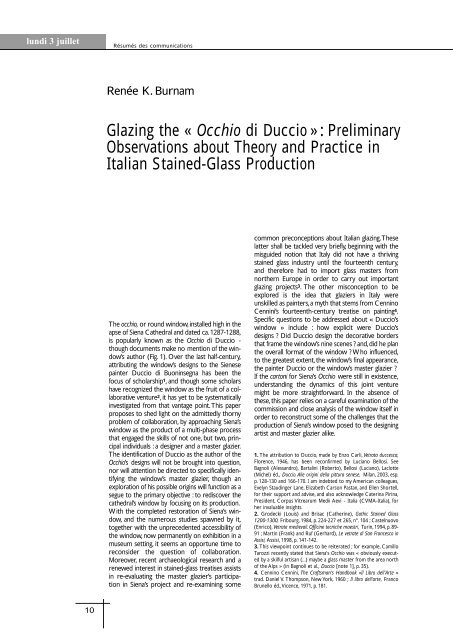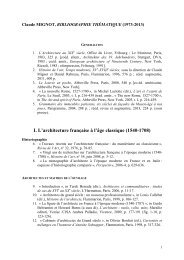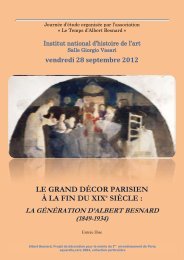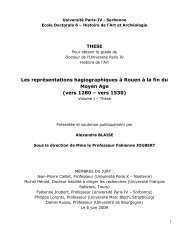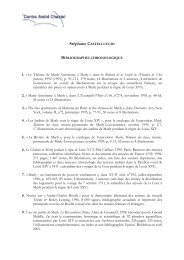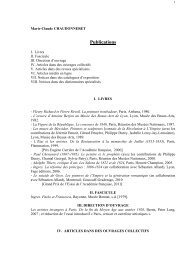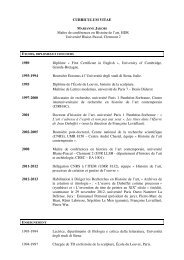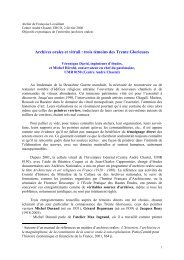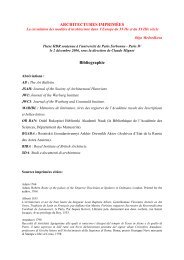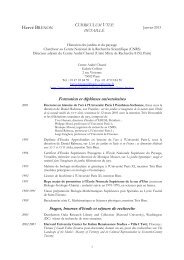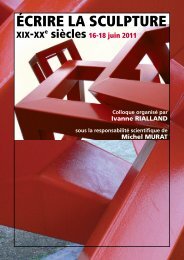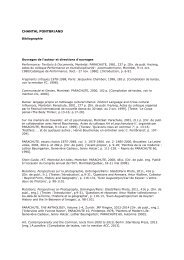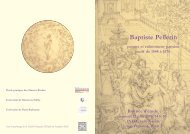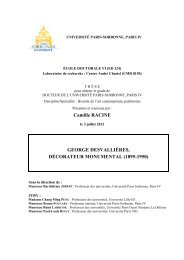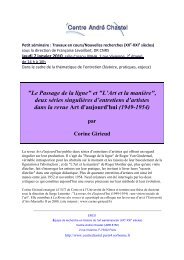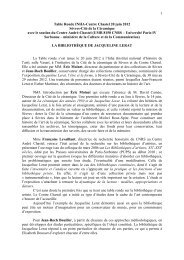Corpus Vitrearum - Centre André Chastel
Corpus Vitrearum - Centre André Chastel
Corpus Vitrearum - Centre André Chastel
You also want an ePaper? Increase the reach of your titles
YUMPU automatically turns print PDFs into web optimized ePapers that Google loves.
lundi 3 juilletRésumés des communicationsRenée K. BurnamGlazing the « Occhio di Duccio » : PreliminaryObservations about Theory and Practice inItalian Stained-Glass ProductionThe occhio, or round window,installed high in theapse of Siena Cathedral and dated ca.1287-1288,is popularly known as the Occhio di Duccio -though documents make no mention of the window’sauthor (Fig. 1). Over the last half-century,attributing the window’s designs to the Sienesepainter Duccio di Buoninsegna has been thefocus of scholarship 1 , and though some scholarshave recognized the window as the fruit of a collaborativeventure 2 , it has yet to be systematicallyinvestigated from that vantage point.This paperproposes to shed light on the admittedly thornyproblem of collaboration, by approaching Siena’swindow as the product of a multi-phase processthat engaged the skills of not one, but two, principalindividuals : a designer and a master glazier.The identification of Duccio as the author of theOcchio’s designs will not be brought into question,nor will attention be directed to specifically identifyingthe window’s master glazier, though anexploration of his possible origins will function as asegue to the primary objective : to rediscover thecathedral’s window by focusing on its production.With the completed restoration of Siena’s window,and the numerous studies spawned by it,together with the unprecedented accessibility ofthe window, now permanently on exhibition in amuseum setting, it seems an opportune time toreconsider the question of collaboration.Moreover, recent archaeological research and arenewed interest in stained-glass treatises assistsin re-evaluating the master glazier’s participationin Siena’s project and re-examining somecommon preconceptions about Italian glazing.Theselatter shall be tackled very briefly, beginning with themisguided notion that Italy did not have a thrivingstained glass industry until the fourteenth century,and therefore had to import glass masters fromnorthern Europe in order to carry out importantglazing projects 3 . The other misconception to beexplored is the idea that glaziers in Italy wereunskilled as painters,a myth that stems from CenninoCennini’s fourteenth-century treatise on painting 4 .Specific questions to be addressed about « Duccio’swindow » include : how explicit were Duccio’sdesigns ? Did Duccio design the decorative bordersthat frame the window’s nine scenes ? and,did he planthe overall format of the window ? Who influenced,to the greatest extent,the window’s final appearance,the painter Duccio or the window’s master glazier ?If the cartoni for Siena’s Occhio were still in existence,understanding the dynamics of this joint venturemight be more straightforward. In the absence ofthese,this paper relies on a careful examination of thecommission and close analysis of the window itself inorder to reconstruct some of the challenges that theproduction of Siena’s window posed to the designingartist and master glazier alike.1. The attribution to Duccio, made by Enzo Carli, Vetrata duccesca,Florence, 1946, has been reconfirmed by Luciano Bellosi. SeeBagnoli (Alessandro), Bartalini (Roberto), Bellosi (Luciano), Laclotte(Michel) éd., Duccio. Alle origini della pittura senese, Milan, 2003, esp.p. 128-130 and 166-170. I am indebted to my American colleagues,Evelyn Staudinger Lane, Elizabeth Carson Pastan, and Ellen Shortell,for their support and advise, and also acknowledge Caterina Pirina,President, <strong>Corpus</strong> <strong>Vitrearum</strong> Medii Aevi - Italia (CVMA-Italia), forher invaluable insights.2. Grodecki (Louis) and Brisac (Catherine), Gothic Stained Glass1200-1300, Fribourg, 1984, p. 224-227 et 265, n°. 104 ; Castelnuovo(Enrico), Vetrate medievali. Officine tecniche maestri, Turin, 1994, p. 89-91 ; Martin (Frank) and Ruf (Gerhard), Le vetrate di San Francesco inAssisi, Assisi, 1998, p. 141-142.3. This viewpoint continues to be reiterated ; for example, CamilloTarozzi recently stated that Siena's Occhio was « obviously executedby a skilful artisan (...) maybe a glass master from the area northof the Alps » (in Bagnoli et al., Duccio [note 1], p. 35).4. Cennino Cennini, The Craftsman's Handbook «Il Libro dell'Arte »trad. Daniel V. Thompson, New York, 1960 ; Il libro dell'arte, FrancoBrunello éd.,Vicence, 1971, p. 181.10


